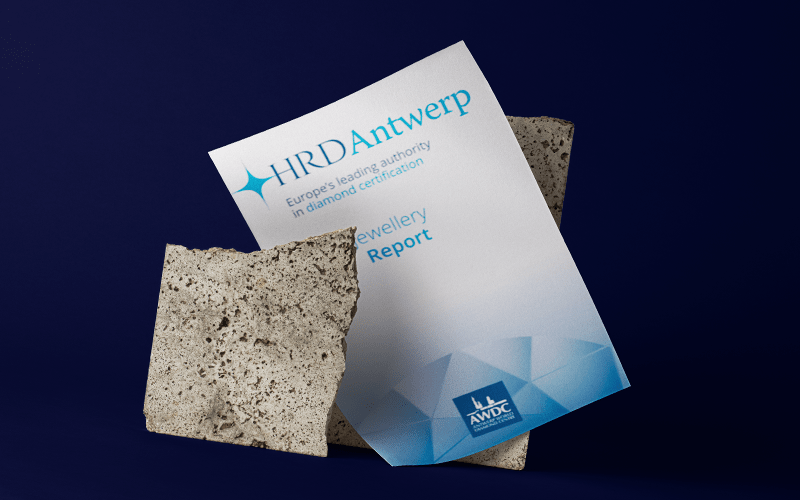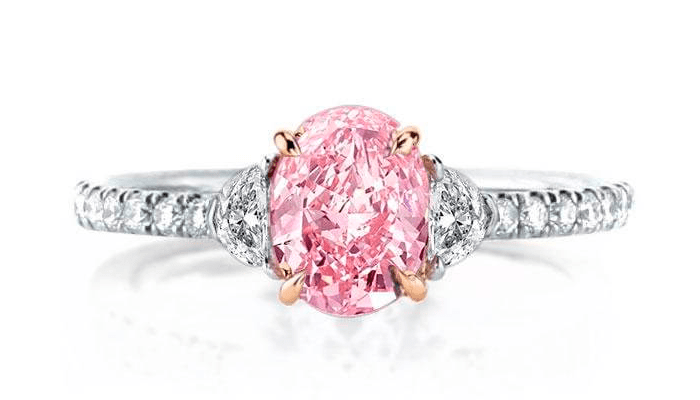HRD certificate is among the grading reports which diamond specialists don’t usually recommend. Why so? Frequently, because of accusations in fraud and loose quality standards. Also, this grading institution is known for causing many problems in the lives of their diamond buyers. Some people ran the venture of relying on HRD certification solely – and years later, regretted investing in the diamond with their irrelevant grading. That’s the reason why many observers strongly recommend to compare HRD grades with GIA grades. It’s always easier to ask for GIA expertise from the very beginning, without even checking the difference with HRD grading. In essence, GIA is the best in the industry when it comes to unbiased evaluation of carat weight, clarity, cut, and color parameters.
Notwithstanding such a loose reputation of the way HRD specialists certify diamonds, let’s check how exactly HRD works and what’s the problems with its reports.
HRD, or Hoge Raad voor Diamant, is a diamond grading institute established in 1973 in Antwerp, Belgium. When it comes to the need to certify diamonds in Europe, the High Council for Diamonds positions itself as the best alternative to GIA. To support this vision, HRD invests tremendous sums in becoming the top representative in the diamond industry and education. In addition, the grading institute cares about its reputation in the eyes of jewelers and customers.
HRD has transformed itself into a research center that is allowed to certify diamonds according to ISO standards. It has its own department that identifies and measures natural diamonds, using top-notch technologies and scientific methods.
However, such a rage for fame has its price. And HRD certification frequently sacrifices the quality of its grading to the need for investing in its diamond prestige. And in the end, it loses GIA in the accuracy of grading all diamond parameters, especially when it comes to clarity and color grades.
The main issue with HRD is its bold interest in the Antwerp World Diamond Centre (AWDC), where it is a leading shareholder. The problems start with the mission of AWDC. As its official documents state, it was established to support diamond businesses by teaching them all the needed practices and business rules of the industry. In other words, it provides the knowledge for diamond dealers to get the best from the diamond trade. By serving this purpose, it sees grades in a diamond certificate as a factor to play with to create a favorable diamond price for each stone.
To favor diamond sellers, HRD specialists play with numbers in several diamond grades. Precisely, the common inconsistencies in grading HRD certified diamonds are two grades more in color and clarity, if to compare with the grades in GIA certificate. These differences allow putting more expensive price tags on the diamonds than GIA can allow itself to put.
Because of that, the HRD approach to diamond grading has a questionable reputation on the diamond market. Notwithstanding this, HRD still has some authority in issuing diamond certificates.

Generally, there are two types of documents that validate an HRD certified diamond. The first one is HRD diamond certificate. That’s the classic form of certifying diamond grades in color, clarity, carat number, and cut. The second one is the HRD diamond identification report. This is a compact document without a graphic representation. It’s relevant for a small stone that weighs less than 1 carat.
To select the specific grades, HRD asks several in-house gemologists to certify a diamond. Each of them considers the diamond grades independently by using innovative equipment. The grading which appears in the diamond report is the result of reaching a consensus between these experts. But the process of certifying doesn’t end here: HRD has the practice of re-checking the previously selected grades in a diamond for accuracy and relevance.
So, like any other diamond grading institute, HRD evaluates the basic parameters of a diamond: clarity, color, cut, and carat weight. Let’s review how HRD assesses all these parameters in its grading practices.
When it comes to cut, HRD measures the exact grade for a diamond through three key dimensions:
Each of these categories can obtain four grades – Excellent, Very Good, Good, or Fair. And the sum of them makes it possible to set a unified grade for Cut in HRD certified diamonds. Since diamond proportions play the key in setting this parameter, the diamond cut in the HRD report is frequently titled “Diamond Proportions.”
For measuring color, the HRD diamond certificate adopts GIA’s D-Z grading scale. For clarity, each color letter receives a wordy description from HRD, like “Exceptional White” or “Tinted White,” which supplement the scale borrowed from GIA. At the same time, a critical difference between HRD and GIA is in choosing the exact grade for the same diamond – for example, if GIA chooses K, HRD is likely to evaluate it as I. In other words, these institutes the same scale but plays with its grades differently.

Clarity in HRD certified diamond is the parameter that indicates the number and severity of imperfections in a stone. Here, HRD adopts a unique measurement scale that contains the following grades:
|
LC |
Loupe-clean |
|
VVS1 |
Very very slightly included 1 |
|
VVS2 |
Very very slightly included 2 |
|
VS1 |
Very slightly included 1 |
|
VS2 |
Very slightly included 2 |
|
SI1 |
Slightly included 1 |
|
SI2 |
Slightly included 2 |
|
P1 |
Pique (or Included) 1 |
|
P2 |
Pique (or Included) 2 |
|
P3 |
Pique (or Included) 3 |
As you can see in the table, the clarity titles are slightly different sometimes, but their meaning is identical to the traditional GIA grading for clarity. Also, HRD measures several attributes of a diamond similar to GIA – including purity, brightness, and placement of both internal and external elements.
And the graphic representation of clarity result is a must for both HRD and GIA. The only exception is the HRD diamond identification report for a stone that is less than 1 carat.
Besides, HRD specialists certify carat, or diamond weight, in their reports. For this evaluation, they adopt the same equipment as any diamond grading institute – including GIA and EGL. HRD uses sensitive scales that weigh the stone and help to set its grade from scanning. All these procedures ensure certifying an accurate number of diamond carats.
Finally, HRD grading involves selecting the finish grade of a stone and determine the diamond’s origin. These parameters help to evaluate the work of a diamond polisher and prove that the stone is natural or lab-grown.
The key specialists in the diamond industry agree that the main HRD problem is its low level of professionalism. The inconsistency of its grading practices result in overpricing while evaluating diamonds. All these problems become sharp when you compare HRD and GIA approach to setting grades.
The most striking difference between HRD and GIA appears in setting the color grade. Just compare the way these two organizations work – and see the problems by yourself. GIA makes different arrangements to ensure objectivity: all the specialists compare a diamond with a master stone independently. They don’t know the results of other specialists. The background for certifying a diamond is purely grey. The organization doesn’t have any interest in diamond trade after certification is completed. In its turn, HRD specialists search for consensus, use complicated equipment, and serve the interests of diamond dealers in AWDC.
As a result, when GIA receives a diamond, it evaluates its color as the strictest laboratory in the world. Numerous tests (including those made by RapNet and Diamonds Pro) showed that the GIA institute is likely to put the lowest grade possible for color, safeguarding the interests of buyers. The same tests don’t recommend considering HRD for certification – it has bad results (the worst have EGL HK and EGL Israel).
Following the ideas of the key specialists, Diamond Registry selects the stones with GIA certificates only. This measure ensures the highest quality of our service. Even if you’re in Europe, it’s always safer to ask for a free delivery of a GIA-certified diamond. Contact our consultants, and we’ll help you with this task!

